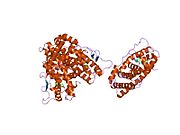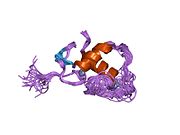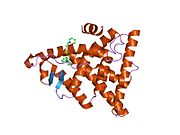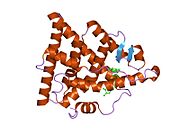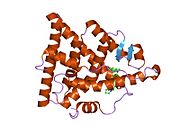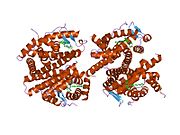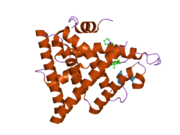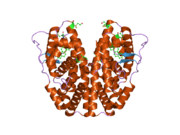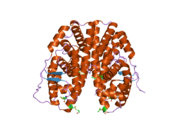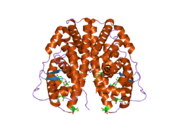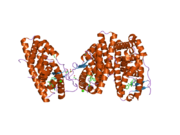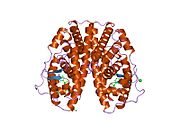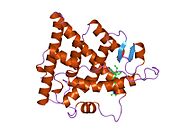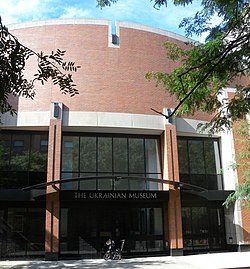에스트로겐수용체α
Estrogen receptor alphaNR3A1로도 알려진 에스트로겐 수용체 알파(ERα)는 성호르몬 에스트로겐에 의해 활성화되는 핵 수용체인 에스트로겐 수용체의 두 가지 주요 유형 중 하나이다.인간에서 ERα는 유전자 ESR1(ESTrogen Receptor [5][6][7]1)에 의해 암호화된다.
구조.
에스트로겐 수용체(ER)는 호르몬 결합, DNA 결합 및 [8]전사의 활성화에 중요한 여러 도메인으로 구성된 리간드 활성 전사 인자입니다.대체 스플라이싱은 여러 개의 ESR1 mRNA 전사물을 생성하며, 이는 주로 5-prime 비번역 영역에서 다르다.번역된 수용체들은 [9][10]더 적은 가변성을 보인다.
리간드
어거니스트
비선택적
선택적인
ERβ에 대한 ERα 선택적 작용제에는 다음이 포함된다.
- 프로필피라졸레트리올(PPT)
- 16α-LE2(Cpd1471)
- 16α-IE2
- ERA-63(ORG-3766)
- SKF-82,958 – D-라이크1 수용체 완전작용제
- (R,R)-테트라히드로크라이센(R,R)-THC)– 실제로 ERβ보다 선택적이지 않고 오히려 ERβ의 작용제 대신 길항제
혼재
대항마
비선택적
- 항에스트로겐(예: 풀베스트란트, ICI-164384, 에탐옥시트리페톨)
선택적인
ERβ에 대한 ERα 선택적 길항제에는 다음이 포함된다.
- 메틸피페리디노피라졸(MPP)
친화력
| 리간드 | 기타 이름 | 상대 바인딩 친화도(RBA, %)a | 절대 바인딩 친화도(Ki, nM)a | 액션. | ||
|---|---|---|---|---|---|---|
| ERα | ERβ | ERα | ERβ | |||
| 에스트라디올 | E2; 17β-에스트라디올 | 100 | 100 | 0.115 (0.04–0.24) | 0.15 (0.10–2.08) | 에스트로겐 |
| 에스트로네 | E1; 17-케토에스트라디올 | 16.39 (0.7–60) | 6.5 (1.36–52) | 0.445 (0.3–1.01) | 1.75 (0.35–9.24) | 에스트로겐 |
| 에스트리올 | E3, 16α-OH-17β-E2 | 12.65 (4.03–56) | 26 (14.0–44.6) | 0.45 (0.35–1.4) | 0.7 (0.63–0.7) | 에스트로겐 |
| 에스테트롤 | E4, 15α, 16α-Di-OH-17β-E2 | 4.0 | 3.0 | 4.9 | 19 | 에스트로겐 |
| 알파트라디올 | 17α-에스트라디올 | 20.5 (7–80.1) | 8.195 (2–42) | 0.2–0.52 | 0.43–1.2 | 대사물 |
| 16-에피스트리올 | 16β-히드록시-17β-에스트라디올 | 7.795 (4.94–63) | 50 | ? | ? | 대사물 |
| 17-에피스트리올 | 16α-히드록시-17α-에스트라디올 | 55.45 (29–103) | 79–80 | ? | ? | 대사물 |
| 16,17-에피스트리올 | 16β-히드록시-17α-에스트라디올 | 1.0 | 13 | ? | ? | 대사물 |
| 2-히드록시에스트라디올 | 2-OH-E2 | 22 (7–81) | 11–35 | 2.5 | 1.3 | 대사물 |
| 2-메톡시에스트라디올 | 2-MeO-E2 | 0.0027–2.0 | 1.0 | ? | ? | 대사물 |
| 4-히드록시에스트라디올 | 4-OH-E2 | 13 (8–70) | 7–56 | 1.0 | 1.9 | 대사물 |
| 4-메톡시에스트라디올 | 4-MeO-E2 | 2.0 | 1.0 | ? | ? | 대사물 |
| 2-히드록시에스트론 | 2-OH-E1 | 2.0–4.0 | 0.2–0.4 | ? | ? | 대사물 |
| 2-메톡시에스트론 | 2-MeO-E1 | < 0 . 001 ~< 1 | 1 미만 | ? | ? | 대사물 |
| 4-히드록시에스트론 | 4-OH-E1 | 1.0–2.0 | 1.0 | ? | ? | 대사물 |
| 4-메톡시에스트론 | 4-MeO-E1 | 1 미만 | 1 미만 | ? | ? | 대사물 |
| 16α-히드록시에스트론 | 16α-OH-E1, 17-케토에스트리올 | 2.0–6.5 | 35 | ? | ? | 대사물 |
| 2-히드록시에스트리올 | 2-OH-E3 | 2.0 | 1.0 | ? | ? | 대사물 |
| 4-메톡시에스트리올 | 4-MeO-E3 | 1.0 | 1.0 | ? | ? | 대사물 |
| 에스트라디올 황산염 | E2S; 에스트라디올 3-황산염 | 1 미만 | 1 미만 | ? | ? | 대사물 |
| 이황산 에스트라디올 | 에스트라디올 3,17β-이황산염 | 0.0004 | ? | ? | ? | 대사물 |
| 에스트라디올 3-글루쿠로니드 | E2-3G | 0.0079 | ? | ? | ? | 대사물 |
| 에스트라디올 17β-글루쿠로니드 | E2-17G | 0.0015 | ? | ? | ? | 대사물 |
| 에스트라디올3-글루크17β-황산 | E2-3G-17S | 0.0001 | ? | ? | ? | 대사물 |
| 황산에스트론 | E1S; 에스트론 3-황산염 | 1 미만 | 1 미만 | 10을 넘다 | 10을 넘다 | 대사물 |
| 에스트라디올 안식향산염 | EB; 에스트라디올 3-벤조산염 | 10 | ? | ? | ? | 에스트로겐 |
| 에스트라디올 17β-벤조산염 | E2-17B | 11.3 | 32.6 | ? | ? | 에스트로겐 |
| 에스트론메틸에테르 | 에스트론 3-메틸에테르 | 0.145 | ? | ? | ? | 에스트로겐 |
| ent-Est-Estradiol | 1-에스트라디올 | 1.31–12.34 | 9.44–80.07 | ? | ? | 에스트로겐 |
| 에퀼린 | 7-데히드로에스트론 | 13 (4.0–28.9) | 13.0–49 | 0.79 | 0.36 | 에스트로겐 |
| 에퀼레닌 | 6,8-디데히드로에스트론 | 2.0–15 | 7.0–20 | 0.64 | 0.62 | 에스트로겐 |
| 17β-디히드로에퀼린 | 7-데히드로-17β-에스트라디올 | 7.9–113 | 7.9–108 | 0.09 | 0.17 | 에스트로겐 |
| 17α-디히드로에퀼린 | 7-데히드로-17α-에스트라디올 | 18.6 (18–41) | 14–32 | 0.24 | 0.57 | 에스트로겐 |
| 17β-디히드로에퀼레닌 | 6,8-디데히드로-17β-에스트라디올 | 35–68 | 90–100 | 0.15 | 0.20 | 에스트로겐 |
| 17α-디히드로에퀼레닌 | 6,8-디데히드로-17α-에스트라디올 | 20 | 49 | 0.50 | 0.37 | 에스트로겐 |
| Ⅱ-에스트라디올8 | 8,9-데히드로-17β-에스트라디올 | 68 | 72 | 0.15 | 0.25 | 에스트로겐 |
| Ⅱ-에스트론8 | 8,9-데히드로에스트론 | 19 | 32 | 0.52 | 0.57 | 에스트로겐 |
| 에티닐에스트라디올 | EE; 17α-에티닐-17β-E2 | 120.9 (68.8–480) | 44.4 (2.0–144) | 0.02–0.05 | 0.29–0.81 | 에스트로겐 |
| 메스트라놀 | EE 3-메틸에테르 | ? | 2.5 | ? | ? | 에스트로겐 |
| 목세스트롤 | RU-2858; 11β-메톡시-EE | 35–43 | 5–20 | 0.5 | 2.6 | 에스트로겐 |
| 메틸에스트라디올 | 17α-메틸-17β-에스트라디올 | 70 | 44 | ? | ? | 에스트로겐 |
| 디에틸스틸베스트롤 | DES; 스틸베스트롤 | 129.5 (89.1–468) | 219.63 (61.2–295) | 0.04 | 0.05 | 에스트로겐 |
| 헥스테롤 | 디히드로디에틸스틸베스트롤 | 153.6 (31–302) | 60–234 | 0.06 | 0.06 | 에스트로겐 |
| 디엔스트롤 | 데히드로스틸베스트롤 | 37 (20.4–223) | 56–404 | 0.05 | 0.03 | 에스트로겐 |
| 벤제스트롤(B2) | – | 114 | ? | ? | ? | 에스트로겐 |
| 클로로트리아니센 | TACE | 1.74 | ? | 15.30 | ? | 에스트로겐 |
| 트리페닐에틸렌 | TPE | 0.074 | ? | ? | ? | 에스트로겐 |
| 트리페닐브로모에틸렌 | TPME | 2.69 | ? | ? | ? | 에스트로겐 |
| 타목시펜 | ICI-46,474 | 3 (0.1–47) | 3.33 (0.28–6) | 3.4–9.69 | 2.5 | 섬 |
| 아피목시펜 | 4-히드록시타목시펜; 4-OHT | 100.1 (1.7–257) | 10 (0.98–339) | 2.3 (0.1–3.61) | 0.04–4.8 | 섬 |
| 토레미펜 | 4-클로로타목시펜; 4-CT | ? | ? | 7.14–20.3 | 15.4 | 섬 |
| 클로미펜 | MRL-41 | 25 (19.2–37.2) | 12 | 0.9 | 1.2 | 섬 |
| 사이클로페닐 | F-6066; Sexovid | 151–152 | 243 | ? | ? | 섬 |
| 나폭시딘 | U-11,000a | 30.9–44 | 16 | 0.3 | 0.8 | 섬 |
| 랄록시펜 | – | 41.2 (7.8–69) | 5.34 (0.54–16) | 0.188–0.52 | 20.2 | 섬 |
| 아르조시펜 | LY-35,381 | ? | ? | 0.179 | ? | 섬 |
| 라소폭시펜 | CP-336,156 | 10.2–166 | 19.0 | 0.229 | ? | 섬 |
| 오르멜록시펜 | 센트로만 | ? | ? | 0.313 | ? | 섬 |
| 레보르멜록시펜 | 6720-CDRI, NNC-460,020 | 1.55 | 1.88 | ? | ? | 섬 |
| 오스페미펜 | 데아미노히드록시토레미펜 | 0.82–2.63 | 0.59–1.22 | ? | ? | 섬 |
| 바제독시펜 | – | ? | ? | 0.053 | ? | 섬 |
| 에탁스틸 | GW-5638 | 4.30 | 11.5 | ? | ? | 섬 |
| ICI-164,384 | – | 63.5 (3.70–97.7) | 166 | 0.2 | 0.08 | 항에스트로겐 |
| 풀베스트란트 | ICI-182,780 | 43.5 (9.4–325) | 21.65 (2.05–40.5) | 0.42 | 1.3 | 항에스트로겐 |
| 프로필피라졸레트리올 | PPT | 49 (10.0–89.1) | 0.12 | 0.40 | 92.8 | ERα작용제 |
| 16α-LE2 | 16α-락톤-17β-에스트라디올 | 14.6–57 | 0.089 | 0.27 | 131 | ERα작용제 |
| 16α-요도-E2 | 16α-요도-17β-에스트라디올 | 30.2 | 2.30 | ? | ? | ERα작용제 |
| 메틸피페리디노피라졸 | MPP | 11 | 0.05 | ? | ? | ERα 길항제 |
| 다이어리프로피오니트릴 | DPN | 0.12–0.25 | 6.6–18 | 32.4 | 1.7 | ERβ작용제 |
| 8β-VE2 | 8β-비닐-17β-에스트라디올 | 0.35 | 22.0–83 | 12.9 | 0.50 | ERβ작용제 |
| 프리나베렐 | ERB-041; WAY-202,041 | 0.27 | 67–72 | ? | ? | ERβ작용제 |
| ERB-196 | 웨이-202,196 | ? | 180 | ? | ? | ERβ작용제 |
| 에르테베렐 | SERBA-1, LY-500, 307 | ? | ? | 2.68 | 0.19 | ERβ작용제 |
| SERBA-2 | – | ? | ? | 14.5 | 1.54 | ERβ작용제 |
| 쿠메스트롤 | – | 9.225 (0.0117–94) | 64.125 (0.41–185) | 0.14–80.0 | 0.07–27.0 | 제노에스트로겐 |
| 제니스테인 | – | 0.445 (0.0012–16) | 33.42 (0.86–87) | 2.6–126 | 0.3–12.8 | 제노에스트로겐 |
| 에콜 | – | 0.2–0.287 | 0.85 (0.10–2.85) | ? | ? | 제노에스트로겐 |
| 다이제인 | – | 0.07 (0.0018–9.3) | 0.7865 (0.04–17.1) | 2.0 | 85.3 | 제노에스트로겐 |
| 바이오차닌 A | – | 0.04 (0.022–0.15) | 0.6225 (0.010–1.2) | 174 | 8.9 | 제노에스트로겐 |
| 켐페롤 | – | 0.07 (0.029–0.10) | 2.2 (0.002–3.00) | ? | ? | 제노에스트로겐 |
| 나링게닌 | – | 0.0054(<0.001~0.01) | 0.15 (0.11–0.33) | ? | ? | 제노에스트로겐 |
| 8-프레닐나링게닌 | 8-PN | 4.4 | ? | ? | ? | 제노에스트로겐 |
| 케르세틴 | – | 0.001~0.01 미만 | 0.002–0.040 | ? | ? | 제노에스트로겐 |
| 이프리플라본 | – | 0.01 미만 | 0.01 미만 | ? | ? | 제노에스트로겐 |
| 미로에스트롤 | – | 0.39 | ? | ? | ? | 제노에스트로겐 |
| 디옥시미로에스트롤 | – | 2.0 | ? | ? | ? | 제노에스트로겐 |
| β-시토스테롤 | – | 0.001~0.0875 미만 | 0.001 ~ 0.016 미만 | ? | ? | 제노에스트로겐 |
| 레스베라트롤 | – | 0.001~0.0032 미만 | ? | ? | ? | 제노에스트로겐 |
| α-제랄레놀 | – | 48 (13–52.5) | ? | ? | ? | 제노에스트로겐 |
| β-제랄레놀 | – | 0.6 (0.032–13) | ? | ? | ? | 제노에스트로겐 |
| 제라놀 | α-제알라놀 | 48–111 | ? | ? | ? | 제노에스트로겐 |
| 탈레라놀 | β-제알라놀 | 16 (13–17.8) | 14 | 0.8 | 0.9 | 제노에스트로겐 |
| 제랄레논 | 젠 | 7.68 (2.04–28) | 9.45 (2.43–31.5) | ? | ? | 제노에스트로겐 |
| 지아라노네 | 잔 | 0.51 | ? | ? | ? | 제노에스트로겐 |
| 비스페놀 A | BPA | 0.0315 (0.008–1.0) | 0.135 (0.002–4.23) | 195 | 35 | 제노에스트로겐 |
| 엔도술판 | EDS | <0.001 ~<0.01 | 0.01 미만 | ? | ? | 제노에스트로겐 |
| 케폰 | 클로르데콘 | 0.0069–0.2 | ? | ? | ? | 제노에스트로겐 |
| o,p'-DDT | – | 0.0073–0.4 | ? | ? | ? | 제노에스트로겐 |
| p,p'-DDT | – | 0.03 | ? | ? | ? | 제노에스트로겐 |
| 메톡시클로르 | p,p'-Dimetoxy-DDT | 0.01(<0.001~0.02) | 0.01–0.13 | ? | ? | 제노에스트로겐 |
| HPTE | 히드록시클로르; p,p'-OH-DDT | 1.2–1.7 | ? | ? | ? | 제노에스트로겐 |
| 테스토스테론 | T; 4-안드로스테놀론 | <0.0001~<0.01 | 0.002 ~ 0.040 미만 | >외부 | >외부 | 안드로겐 |
| 디히드로테스토스테론 | DHT; 5α-안드로스타놀론 | 0.01(<0.001~0.05) | 0.0059–0.17 | 221 –>개요 | 73–1688 | 안드로겐 |
| 난드로론 | 19-노테스토스테론;19-NT | 0.01 | 0.23 | 765 | 53 | 안드로겐 |
| 데히드로에피안드로스테론 | DHEA; 프라스테론 | 0.038(<0.001~0.04) | 0.019–0.07 | 245–1053 | 163–515 | 안드로겐 |
| 5-안드로스테니올 | A5; 안드로스테디올 | 6 | 17 | 3.6 | 0.9 | 안드로겐 |
| 4-안드로스테니올 | – | 0.5 | 0.6 | 23 | 19 | 안드로겐 |
| 4-안드로스테디온 | A4; 안드로스테디온 | 0.01 미만 | 0.01 미만 | >외부 | >외부 | 안드로겐 |
| 3α-안드로스타네디올 | 3α-아디올 | 0.07 | 0.3 | 260 | 48 | 안드로겐 |
| 3β-안드로스타네디올 | 3β-아디올 | 3 | 7 | 6 | 2 | 안드로겐 |
| 안드로스타네디온 | 5α-안드로스타네디온 | 0.01 미만 | 0.01 미만 | >외부 | >외부 | 안드로겐 |
| 에티오콜라네디온 | 5β-안드로스타네디온 | 0.01 미만 | 0.01 미만 | >외부 | >외부 | 안드로겐 |
| 메틸테스토스테론 | 17α-메틸테스토스테론 | 0.0001 미만 | ? | ? | ? | 안드로겐 |
| 에티닐-3α-안드로스타네디올 | 17α-에티닐-3α-아디올 | 4.0 | 0.07 미만 | ? | ? | 에스트로겐 |
| 에티닐-3β-안드로스타네디올 | 17α-에티닐-3β-아디올 | 50 | 5.6 | ? | ? | 에스트로겐 |
| 프로게스테론 | P4; 4-임신 이온 | 0.001~0.6 미만 | 0.001 ~ 0.010 미만 | ? | ? | 프로게스토겐 |
| 노르에스티스토론 | NET; 17α-에티닐-19-NT | 0.085 (0.0015 ~<0.1) | 0.1 (0.01–0.3) | 152 | 1084 | 프로게스토겐 |
| 노레티노드렐 | 5(10)-노레스티론 | 0.5 (0.3–0.7) | <0.1~0.22> | 14 | 53 | 프로게스토겐 |
| 티볼론 | 7α-메틸노레티노드렐 | 0.5 (0.45–2.0) | 0.2–0.076 | ? | ? | 프로게스토겐 |
| δ-티볼론4 | 7α-메틸노레스티론 | 0.069~<0.1 | 0.027~<0.1 | ? | ? | 프로게스토겐 |
| 3α-히드록시티볼론 | – | 2.5 (1.06–5.0) | 0.6–0.8 | ? | ? | 프로게스토겐 |
| 3β-히드록시티볼론 | – | 1.6 (0.75–1.9) | 0.070–0.1 | ? | ? | 프로게스토겐 |
| 각주: = (1) 바인딩 선호도 값은 사용 가능한 값에 따라 "범위"(#–#), "범위"(#–#) 또는 "값"(#) 형식입니다.범위 내의 전체 값 집합은 위키 코드에서 확인할 수 있다. (2) 결합 친화성은 라벨이 부착된 에스트라디올과 인간 ERα 및 ERβ 단백질(Rat ERβ인 Kuiper et al.(1997)의 ERβ 값 제외)을 가진 다양한 체외 시스템에서 변위 연구를 통해 결정되었다.출처:템플릿 페이지를 참조해 주세요. | ||||||
조직 분포 및 기능
ERα는 생식계, 중추신경계, 골격계 [11]및 심혈관계를 포함한 다양한 장기 시스템의 생리학적 발달과 기능에 있어 역할을 한다.따라서 ERα는 자궁과 난소, 남성 생식기, 유선, 뼈, 심장, 시상하부, 뇌하수체, 간, 폐, 신장, 비장 [11][12][13]및 지방조직을 포함한 전신에 널리 발현된다.이러한 조직의 발달과 기능은 ERα 녹아웃 마우스(ERKO)와 같이 활성 ERα 유전자가 없는 동물 모델에서 중단되어 특정 표적 [11][14]장기의 ERα 기능에 대한 예비 이해를 제공합니다.
자궁과 난소
ERα는 여성 생식 표현형의 성숙에 필수적이다.ERα가 없는 경우 ERKO 마우스는 성인 자궁을 형성하여 ERα가 [11][12]자궁의 초기 성장을 중재하지 않을 수 있음을 나타냅니다.그러나 ERα는 이러한 개발을 완료하고 조직의 [14]후속 기능을 수행하는 데 중요한 역할을 합니다.ERα의 활성화는 [13]자궁에서 세포 증식을 유발하는 것으로 알려져 있다.암컷 ERKO 생쥐의 자궁은 저형성이고, 이는 ERα가 에스트로겐 [12]자극에 반응하여 자궁의 유사분열과 분화를 매개한다는 것을 암시한다.
마찬가지로, 사춘기 전 암컷 ERKO 생쥐는 야생형 생쥐와 거의 구별할 수 없는 난소가 발생한다.그러나 ERKO 마우스는 성숙함에 따라 생리와 [12][14]기능 모두에서 비정상적인 난소 표현형을 점진적으로 나타낸다.특히, 암컷 ERKO 생쥐는 출혈성 모낭 낭종을 포함한 확대된 난소가 발생하며, 이 난소 역시 황체가 부족하기 때문에 [11][12][14]배란하지 않는다.이 성인 난소 표현형은 ERα가 없을 때, 에스트로겐이 시상하부에 더 이상 부정적인 피드백을 수행할 수 없으며, 결과적으로 만성적으로 LH 수치가 상승하고 지속적인 난소 [12]자극이 발생함을 시사한다.이러한 결과는 시상하부에서 ERα의 중추적 역할과 난소의 테카 [12]및 간질 세포를 통한 에스트로겐 구동 성숙에 대한 역할을 식별합니다.
남성 생식기
ERα는 수컷 ERKO 생쥐가 불임이고 크기가 작은 [11][14]고환을 나타내기 때문에 수컷 생식 표현형의 성숙과 유지에 유사하게 필수적이다.ERKO 생쥐의 고환 구조와 고환의 정소관 및 정소 상피와 같은 고환 구조의 무결성은 시간이 [11][12]지남에 따라 감소한다.또한 수컷 ERKO 생쥐의 생식능력은 정자형성 장애, 난관 및 사정반응 [11][12]상실 등 성생리학 및 거동의 이상을 저해한다.
유선
ERα의 에스트로겐 자극은 유방 [13]조직의 세포 증식을 촉진하는 것으로 알려져 있다.ERα는 에스트로겐에 [14]대한 유선 반응의 매개체를 통해 성인 표현형의 사춘기 발달을 담당하는 것으로 생각된다.이 역할은 암컷 ERKO 생쥐의 이상과 일치한다. 암컷 ERKO 생쥐의 상피관은 사춘기 이전 길이를 초과하여 성장하지 못하고, 젖분유 구조가 [12]발달하지 않는다.그 결과, ERKO [14]생쥐에서 유즙과 프로락틴 분비를 포함한 유선의 기능이 크게 손상된다.
뼈.
ERα는 뼈에서 발현되는 정도가 보통이지만 뼈의 [13][14]무결성을 유지하는 역할을 하는 것으로 알려져 있다.ERα의 에스트로겐 자극은 표피 성장인자 또는 인슐린 유사 성장인자-1과 같은 성장인자의 방출을 유발하여 뼈의 발달과 [14][12]유지를 조절할 수 있다는 가설이 있다.따라서 수컷 및 암컷 ERKO 마우스는 뼈 길이와 크기가 [14][12]감소합니다.
뇌
ERα를 통한 에스트로겐 시그널링은 시냅스 [14]형성과 시냅스 리모델링과 같은 중추 신경 발달의 다양한 측면에 책임이 있는 것으로 보입니다.뇌에서 ERα는 시상하부, 광학전 영역, 활상핵에서 발견되며, 이 세 가지 모두 생식행동과 연결되어 있으며, 마우스 뇌의 남성화는 ERα [11][14]기능을 통해 이루어지는 것으로 보인다.게다가, 정신병리학 및 신경변성 질환의 모델에서의 연구는 에스트로겐 수용체가 [11][13]뇌에서 에스트로겐의 신경 보호 역할을 매개한다는 것을 시사한다.마지막으로 ERα는 활 모양의 핵과 방실 전위핵의 [15][16]뉴런에서 키스펩틴의 발현을 증가시킴으로써 뇌의 GnRH와 LH 분비에 대한 에스트로겐의 양성 피드백 효과를 매개하는 것으로 보인다.에스트로겐의 부정적인 피드백 효과는 ERα를 통해서도 작동한다고 고전적인 연구들이 제시되었지만, 키스펩틴 발현 뉴런에 ERα가 없는 암컷 쥐들은 부정적인 피드백 [17]반응의 정도를 계속해서 보여주고 있다.
임상적 의의
에스트로겐 불감증 증후군은 에스트로겐에 [18][19][20][21]둔감한 ERα 결함으로 특징지어지는 매우 드문 질환이다.여성의 임상 증상에는 사춘기 유방 발달 부전 및 기타 여성 2차 성징후, 저형성 자궁, 1차 무월경, 다낭성 난소 확대 및 관련 하복부 통증, 가벼운 과안드로겐증(낭포성 여드름으로 관리됨), 뼈 성숙 지연 등이 포함된다.뼈 [21]회전율의 증가남성의 임상 증상에는 경막 폐쇄, 큰 키, 골다공증, 그리고 낮은 정자 [20]생존력 등이 포함되어 있는 것으로 보고되었다.두 사람 모두 높은 [20][21]용량에도 불구하고 외인성 에스트로겐 치료에 전혀 둔감했다.
ERα를 코드하는 유전자의 유전자 다형성은 여성의 유방암, 남성의[22][23] 여성 여성성 흉부 및 [24]월경 이상과 관련이 있다.
코액티베이터
ER-α의 공활성화제에는 다음이 포함됩니다.
상호 작용
에스트로겐 수용체 알파는 다음 물질과 상호작용하는 것으로 나타났습니다.
- AKAP13[30]
- AHR[31][32]
- BRCA1[33][34][35][36]
- CAV1[37]
- CCNC[38]
- CDC25B[39]
- CEBPB[40][41]
- 코브라1[42]
- coup-tfi[43]
- 삐걱거리다[36][44]
- CRSP3[38]
- 사이클린 D1[45]
- DDX17[46]
- DDX5[46][47]
- DNTTIP2[48]
- EP300[36][38][49]
- ESR2[50][51]
- FOXO1[52]
- GREB1[53]
- GTF2H1[54]
- HSPA1A[55]
- HSPA8[55]
- HSP90AA1[56][57]
- ISL1[58]
- JARID1A[59]
- MVP[60]
- MED1[38][61]
- MED12[38]
- MED14[38]
- MED16[38]
- MED24[38][61]
- MED6[38]
- 관리[62]
- MNAT1[63]
- MTA1[64][65]
- NCOA6[66][67]
- NCOA1[38][44][46][68][69]
- NCOA2[46][61][70][71][72]
- NCOA3[46][73][74]
- NRIP1[75][76][77]
- PDLIM1[78]
- POU4F1[79]
- POU4F2[79]
- PRDM2[80]
- PRMT2[81]
- RBM39[82]
- RNF12[78]
- SAFB[83][84]
- SAFB2[85]
- SHC1[86]
- SHP[87][88]
- SMARCA4[68][89]
- SMARCE1[90]
- SRA1[46]
- Src[62][91][92][93]
- TR2[94]
- TR4[95]
- TDG[96]
- 트림24[76][97] 및
- XBP1.[98]
레퍼런스
- ^ a b c GRCh38: 앙상블 릴리즈 89: ENSG00000091831 - 앙상블, 2017년 5월
- ^ a b c GRCm38: 앙상블 릴리즈 89: ENSMUSG000019768 - 앙상블, 2017년 5월
- ^ "Human PubMed Reference:". National Center for Biotechnology Information, U.S. National Library of Medicine.
- ^ "Mouse PubMed Reference:". National Center for Biotechnology Information, U.S. National Library of Medicine.
- ^ "Entrez Gene: ESR1 estrogen receptor 1".
- ^ Walter P, Green S, Greene G, Krust A, Bornert JM, Jeltsch JM, et al. (December 1985). "Cloning of the human estrogen receptor cDNA". Proceedings of the National Academy of Sciences of the United States of America. 82 (23): 7889–7893. Bibcode:1985PNAS...82.7889W. doi:10.1073/pnas.82.23.7889. PMC 390875. PMID 3865204.
- ^ Greene GL, Gilna P, Waterfield M, Baker A, Hort Y, Shine J (March 1986). "Sequence and expression of human estrogen receptor complementary DNA". Science. 231 (4742): 1150–1154. Bibcode:1986Sci...231.1150G. doi:10.1126/science.3753802. PMID 3753802.
- ^ Dahlman-Wright K, Cavailles V, Fuqua SA, Jordan VC, Katzenellenbogen JA, Korach KS, et al. (December 2006). "International Union of Pharmacology. LXIV. Estrogen receptors". Pharmacological Reviews. 58 (4): 773–781. doi:10.1124/pr.58.4.8. PMID 17132854. S2CID 45996586.
- ^ "Entrez Gene: DBI diazepam binding inhibitor (GABA receptor modulator, acyl-Coenzyme A binding protein)".
- ^ Kos M, Reid G, Denger S, Gannon F (December 2001). "Minireview: genomic organization of the human ERalpha gene promoter region". Molecular Endocrinology. 15 (12): 2057–2063. doi:10.1210/mend.15.12.0731. PMID 11731608.
- ^ a b c d e f g h i j Bondesson M, Hao R, Lin CY, Williams C, Gustafsson JÅ (February 2015). "Estrogen receptor signaling during vertebrate development". Biochimica et Biophysica Acta (BBA) - Gene Regulatory Mechanisms. 1849 (2): 142–151. doi:10.1016/j.bbagrm.2014.06.005. PMC 4269570. PMID 24954179.
- ^ a b c d e f g h i j k l Curtis Hewitt S, Couse JF, Korach KS (2000). "Estrogen receptor transcription and transactivation: Estrogen receptor knockout mice: what their phenotypes reveal about mechanisms of estrogen action". Breast Cancer Research. 2 (5): 345–352. doi:10.1186/bcr79. PMC 138656. PMID 11250727.
- ^ a b c d e Paterni I, Granchi C, Katzenellenbogen JA, Minutolo F (November 2014). "Estrogen receptors alpha (ERα) and beta (ERβ): subtype-selective ligands and clinical potential". Steroids. 90: 13–29. doi:10.1016/j.steroids.2014.06.012. PMC 4192010. PMID 24971815.
- ^ a b c d e f g h i j k l Lee HR, Kim TH, Choi KC (June 2012). "Functions and physiological roles of two types of estrogen receptors, ERα and ERβ, identified by estrogen receptor knockout mouse". Laboratory Animal Research. 28 (2): 71–76. doi:10.5625/lar.2012.28.2.71. PMC 3389841. PMID 22787479.
- ^ Clarkson J (April 2013). "Effects of estradiol on kisspeptin neurons during puberty". Frontiers in Neuroendocrinology. 34 (2): 120–131. doi:10.1016/j.yfrne.2013.02.002. PMID 23500175. S2CID 26118271.
- ^ Moenter SM, Chu Z, Christian CA (March 2009). "Neurobiological mechanisms underlying oestradiol negative and positive feedback regulation of gonadotrophin-releasing hormone neurones". Journal of Neuroendocrinology. 21 (4): 327–333. doi:10.1111/j.1365-2826.2009.01826.x. PMC 2738426. PMID 19207821.
- ^ Plant TM (August 2015). "60 YEARS OF NEUROENDOCRINOLOGY: The hypothalamo-pituitary-gonadal axis". The Journal of Endocrinology. 226 (2): T41–T54. doi:10.1530/JOE-15-0113. PMC 4498991. PMID 25901041.
- ^ Jameson JL, De Groot LJ (February 2015). Endocrinology: Adult and Pediatric. Elsevier Health Sciences. pp. 238–. ISBN 978-0-323-32195-2.
- ^ Korach KS, Couse JF, Curtis SW, Washburn TF, Lindzey J, Kimbro KS, et al. (1996). "Estrogen receptor gene disruption: molecular characterization and experimental and clinical phenotypes". Recent Progress in Hormone Research. 51: 159–86, discussion 186–8. PMID 8701078.
- ^ a b c Smith EP, Boyd J, Frank GR, Takahashi H, Cohen RM, Specker B, et al. (October 1994). "Estrogen resistance caused by a mutation in the estrogen-receptor gene in a man". The New England Journal of Medicine. 331 (16): 1056–1061. doi:10.1056/NEJM199410203311604. PMID 8090165.
- ^ a b c Quaynor SD, Stradtman EW, Kim HG, Shen Y, Chorich LP, Schreihofer DA, Layman LC (July 2013). "Delayed puberty and estrogen resistance in a woman with estrogen receptor α variant". The New England Journal of Medicine. 369 (2): 164–171. doi:10.1056/NEJMoa1303611. PMC 3823379. PMID 23841731.
- ^ Jahandoost S, Farhanghian P, Abbasi S (2017). "The Effects of Sex Protein Receptors and Sex Steroid Hormone Gene Polymorphisms on Breast Cancer Risk". Journal of the National Medical Association. 109 (2): 126–138. doi:10.1016/j.jnma.2017.02.003. PMID 28599754.
- ^ Eren E, Edgunlu T, Korkmaz HA, Cakir ED, Demir K, Cetin ES, Celik SK (May 2014). "Genetic variants of estrogen beta and leptin receptors may cause gynecomastia in adolescent". Gene. 541 (2): 101–106. doi:10.1016/j.gene.2014.03.013. PMID 24625355.
- ^ Woo HY, Kim KH, Lim SW (February 2010). "Estrogen receptor 1, glutathione S-transferase P1, glutathione S-transferase M1, and glutathione S-transferase T1 genes with dysmenorrhea in Korean female adolescents". The Korean Journal of Laboratory Medicine. 30 (1): 76–83. doi:10.3343/kjlm.2010.30.1.76. PMID 20197727.
- ^ Shang Y, Brown M (March 2002). "Molecular determinants for the tissue specificity of SERMs". Science. 295 (5564): 2465–2468. Bibcode:2002Sci...295.2465S. doi:10.1126/science.1068537. PMID 11923541. S2CID 30634073.
- ^ Smith CL, O'Malley BW (February 2004). "Coregulator function: a key to understanding tissue specificity of selective receptor modulators". Endocrine Reviews. 25 (1): 45–71. doi:10.1210/er.2003-0023. PMID 14769827.
- ^ Anzick SL, Kononen J, Walker RL, Azorsa DO, Tanner MM, Guan XY, et al. (August 1997). "AIB1, a steroid receptor coactivator amplified in breast and ovarian cancer". Science. 277 (5328): 965–968. doi:10.1126/science.277.5328.965. PMID 9252329.
- ^ Gururaj AE, Peng S, Vadlamudi RK, Kumar R (August 2007). "Estrogen induces expression of BCAS3, a novel estrogen receptor-alpha coactivator, through proline-, glutamic acid-, and leucine-rich protein-1 (PELP1)". Molecular Endocrinology. 21 (8): 1847–1860. doi:10.1210/me.2006-0514. PMID 17505058.
- ^ Vadlamudi RK, Wang RA, Mazumdar A, Kim Y, Shin J, Sahin A, Kumar R (October 2001). "Molecular cloning and characterization of PELP1, a novel human coregulator of estrogen receptor alpha". The Journal of Biological Chemistry. 276 (41): 38272–38279. doi:10.1074/jbc.M103783200. PMID 11481323.
- ^ Rubino D, Driggers P, Arbit D, Kemp L, Miller B, Coso O, et al. (May 1998). "Characterization of Brx, a novel Dbl family member that modulates estrogen receptor action". Oncogene. 16 (19): 2513–2526. doi:10.1038/sj.onc.1201783. PMID 9627117. S2CID 20906586.
- ^ Wormke M, Stoner M, Saville B, Walker K, Abdelrahim M, Burghardt R, Safe S (March 2003). "The aryl hydrocarbon receptor mediates degradation of estrogen receptor alpha through activation of proteasomes". Molecular and Cellular Biology. 23 (6): 1843–1855. doi:10.1128/MCB.23.6.1843-1855.2003. PMC 149455. PMID 12612060.
- ^ Klinge CM, Kaur K, Swanson HI (January 2000). "The aryl hydrocarbon receptor interacts with estrogen receptor alpha and orphan receptors COUP-TFI and ERRalpha1". Archives of Biochemistry and Biophysics. 373 (1): 163–174. doi:10.1006/abbi.1999.1552. PMID 10620335.
- ^ Zheng L, Annab LA, Afshari CA, Lee WH, Boyer TG (August 2001). "BRCA1 mediates ligand-independent transcriptional repression of the estrogen receptor". Proceedings of the National Academy of Sciences of the United States of America. 98 (17): 9587–9592. Bibcode:2001PNAS...98.9587Z. doi:10.1073/pnas.171174298. PMC 55496. PMID 11493692.
- ^ Fan S, Ma YX, Wang C, Yuan RQ, Meng Q, Wang JA, et al. (January 2001). "Role of direct interaction in BRCA1 inhibition of estrogen receptor activity". Oncogene. 20 (1): 77–87. doi:10.1038/sj.onc.1204073. PMID 11244506. S2CID 24657209.
- ^ Kawai H, Li H, Chun P, Avraham S, Avraham HK (October 2002). "Direct interaction between BRCA1 and the estrogen receptor regulates vascular endothelial growth factor (VEGF) transcription and secretion in breast cancer cells". Oncogene. 21 (50): 7730–7739. doi:10.1038/sj.onc.1205971. PMID 12400015. S2CID 32740995.
- ^ a b c Fan S, Ma YX, Wang C, Yuan RQ, Meng Q, Wang JA, et al. (January 2002). "p300 Modulates the BRCA1 inhibition of estrogen receptor activity". Cancer Research. 62 (1): 141–151. PMID 11782371.
- ^ Schlegel A, Wang C, Pestell RG, Lisanti MP (October 2001). "Ligand-independent activation of oestrogen receptor alpha by caveolin-1". The Biochemical Journal. 359 (Pt 1): 203–210. doi:10.1042/0264-6021:3590203. PMC 1222136. PMID 11563984.
- ^ a b c d e f g h i j Kang YK, Guermah M, Yuan CX, Roeder RG (March 2002). "The TRAP/Mediator coactivator complex interacts directly with estrogen receptors alpha and beta through the TRAP220 subunit and directly enhances estrogen receptor function in vitro". Proceedings of the National Academy of Sciences of the United States of America. 99 (5): 2642–2647. Bibcode:2002PNAS...99.2642K. doi:10.1073/pnas.261715899. PMC 122401. PMID 11867769.
- ^ Ma ZQ, Liu Z, Ngan ES, Tsai SY (December 2001). "Cdc25B functions as a novel coactivator for the steroid receptors". Molecular and Cellular Biology. 21 (23): 8056–8067. doi:10.1128/MCB.21.23.8056-8067.2001. PMC 99972. PMID 11689696.
- ^ Boruk M, Savory JG, Haché RJ (November 1998). "AF-2-dependent potentiation of CCAAT enhancer binding protein beta-mediated transcriptional activation by glucocorticoid receptor". Molecular Endocrinology. 12 (11): 1749–1763. doi:10.1210/mend.12.11.0191. PMID 9817600.
- ^ Stein B, Yang MX (September 1995). "Repression of the interleukin-6 promoter by estrogen receptor is mediated by NF-kappa B and C/EBP beta". Molecular and Cellular Biology. 15 (9): 4971–4979. doi:10.1128/MCB.15.9.4971. PMC 230744. PMID 7651415.
- ^ Aiyar SE, Sun JL, Blair AL, Moskaluk CA, Lu YZ, Ye QN, et al. (September 2004). "Attenuation of estrogen receptor alpha-mediated transcription through estrogen-stimulated recruitment of a negative elongation factor". Genes & Development. 18 (17): 2134–2146. doi:10.1101/gad.1214104. PMC 515291. PMID 15342491.
- ^ Métivier R, Gay FA, Hübner MR, Flouriot G, Salbert G, Gannon F, et al. (July 2002). "Formation of an hER alpha-COUP-TFI complex enhances hER alpha AF-1 through Ser118 phosphorylation by MAPK". The EMBO Journal. 21 (13): 3443–3453. doi:10.1093/emboj/cdf344. PMC 126093. PMID 12093745.
- ^ a b Sheppard HM, Harries JC, Hussain S, Bevan C, Heery DM (January 2001). "Analysis of the steroid receptor coactivator 1 (SRC1)-CREB binding protein interaction interface and its importance for the function of SRC1". Molecular and Cellular Biology. 21 (1): 39–50. doi:10.1128/MCB.21.1.39-50.2001. PMC 86566. PMID 11113179.
- ^ Zwijsen RM, Wientjens E, Klompmaker R, van der Sman J, Bernards R, Michalides RJ (February 1997). "CDK-independent activation of estrogen receptor by cyclin D1". Cell. 88 (3): 405–415. doi:10.1016/S0092-8674(00)81879-6. hdl:1874/21074. PMID 9039267. S2CID 16492666.
- ^ a b c d e f Watanabe M, Yanagisawa J, Kitagawa H, Takeyama K, Ogawa S, Arao Y, et al. (March 2001). "A subfamily of RNA-binding DEAD-box proteins acts as an estrogen receptor alpha coactivator through the N-terminal activation domain (AF-1) with an RNA coactivator, SRA". The EMBO Journal. 20 (6): 1341–1352. doi:10.1093/emboj/20.6.1341. PMC 145523. PMID 11250900.
- ^ Endoh H, Maruyama K, Masuhiro Y, Kobayashi Y, Goto M, Tai H, et al. (August 1999). "Purification and identification of p68 RNA helicase acting as a transcriptional coactivator specific for the activation function 1 of human estrogen receptor alpha". Molecular and Cellular Biology. 19 (8): 5363–5372. doi:10.1128/MCB.19.8.5363. PMC 84379. PMID 10409727.
- ^ Bu H, Kashireddy P, Chang J, Zhu YT, Zhang Z, Zheng W, et al. (April 2004). "ERBP, a novel estrogen receptor binding protein enhancing the activity of estrogen receptor". Biochemical and Biophysical Research Communications. 317 (1): 54–59. doi:10.1016/j.bbrc.2004.02.179. PMID 15047147.
- ^ Fajas L, Egler V, Reiter R, Hansen J, Kristiansen K, Debril MB, et al. (December 2002). "The retinoblastoma-histone deacetylase 3 complex inhibits PPARgamma and adipocyte differentiation". Developmental Cell. 3 (6): 903–910. doi:10.1016/S1534-5807(02)00360-X. PMID 12479814.
- ^ Ogawa S, Inoue S, Watanabe T, Hiroi H, Orimo A, Hosoi T, et al. (February 1998). "The complete primary structure of human estrogen receptor beta (hER beta) and its heterodimerization with ER alpha in vivo and in vitro". Biochemical and Biophysical Research Communications. 243 (1): 122–126. doi:10.1006/bbrc.1997.7893. PMID 9473491.
- ^ Poelzl G, Kasai Y, Mochizuki N, Shaul PW, Brown M, Mendelsohn ME (March 2000). "Specific association of estrogen receptor beta with the cell cycle spindle assembly checkpoint protein, MAD2". Proceedings of the National Academy of Sciences of the United States of America. 97 (6): 2836–2839. Bibcode:2000PNAS...97.2836P. doi:10.1073/pnas.050580997. PMC 16016. PMID 10706629.
- ^ Schuur ER, Loktev AV, Sharma M, Sun Z, Roth RA, Weigel RJ (September 2001). "Ligand-dependent interaction of estrogen receptor-alpha with members of the forkhead transcription factor family". The Journal of Biological Chemistry. 276 (36): 33554–33560. doi:10.1074/jbc.M105555200. PMID 11435445. S2CID 11652289.
- ^ Deschênes J, Bourdeau V, White JH, Mader S (June 2007). "Regulation of GREB1 transcription by estrogen receptor alpha through a multipartite enhancer spread over 20 kb of upstream flanking sequences". The Journal of Biological Chemistry. 282 (24): 17335–17339. doi:10.1074/jbc.C700030200. PMID 17463000. S2CID 24262059.
- ^ Chen D, Riedl T, Washbrook E, Pace PE, Coombes RC, Egly JM, Ali S (July 2000). "Activation of estrogen receptor alpha by S118 phosphorylation involves a ligand-dependent interaction with TFIIH and participation of CDK7". Molecular Cell. 6 (1): 127–137. doi:10.1016/S1097-2765(00)00014-9. PMID 10949034.
- ^ a b Dhamad AE, Zhou Z, Zhou J, Du Y (2016). "Systematic Proteomic Identification of the Heat Shock Proteins (Hsp) that Interact with Estrogen Receptor Alpha (ERα) and Biochemical Characterization of the ERα-Hsp70 Interaction". PLOS ONE. 11 (8): e0160312. Bibcode:2016PLoSO..1160312D. doi:10.1371/journal.pone.0160312. PMC 4970746. PMID 27483141.
- ^ Nair SC, Toran EJ, Rimerman RA, Hjermstad S, Smithgall TE, Smith DF (December 1996). "A pathway of multi-chaperone interactions common to diverse regulatory proteins: estrogen receptor, Fes tyrosine kinase, heat shock transcription factor Hsf1, and the aryl hydrocarbon receptor". Cell Stress & Chaperones. 1 (4): 237–250. PMC 376461. PMID 9222609.
- ^ Lee MO, Kim EO, Kwon HJ, Kim YM, Kang HJ, Kang H, Lee JE (February 2002). "Radicicol represses the transcriptional function of the estrogen receptor by suppressing the stabilization of the receptor by heat shock protein 90". Molecular and Cellular Endocrinology. 188 (1–2): 47–54. doi:10.1016/S0303-7207(01)00753-5. PMID 11911945. S2CID 37933406.
- ^ Gay F, Anglade I, Gong Z, Salbert G (October 2000). "The LIM/homeodomain protein islet-1 modulates estrogen receptor functions". Molecular Endocrinology. 14 (10): 1627–1648. doi:10.1210/mend.14.10.0538. PMID 11043578.
- ^ Chan SW, Hong W (July 2001). "Retinoblastoma-binding protein 2 (Rbp2) potentiates nuclear hormone receptor-mediated transcription". The Journal of Biological Chemistry. 276 (30): 28402–28412. doi:10.1074/jbc.M100313200. PMID 11358960. S2CID 22993127.
- ^ Abbondanza C, Rossi V, Roscigno A, Gallo L, Belsito A, Piluso G, et al. (June 1998). "Interaction of vault particles with estrogen receptor in the MCF-7 breast cancer cell". The Journal of Cell Biology. 141 (6): 1301–1310. doi:10.1083/jcb.141.6.1301. PMC 2132791. PMID 9628887.
- ^ a b c Kitagawa H, Fujiki R, Yoshimura K, Mezaki Y, Uematsu Y, Matsui D, et al. (June 2003). "The chromatin-remodeling complex WINAC targets a nuclear receptor to promoters and is impaired in Williams syndrome". Cell. 113 (7): 905–917. doi:10.1016/S0092-8674(03)00436-7. PMID 12837248. S2CID 18686879.
- ^ a b Teo AK, Oh HK, Ali RB, Li BF (October 2001). "The modified human DNA repair enzyme O(6)-methylguanine-DNA methyltransferase is a negative regulator of estrogen receptor-mediated transcription upon alkylation DNA damage". Molecular and Cellular Biology. 21 (20): 7105–7114. doi:10.1128/MCB.21.20.7105-7114.2001. PMC 99886. PMID 11564893.
- ^ Talukder AH, Mishra SK, Mandal M, Balasenthil S, Mehta S, Sahin AA, et al. (March 2003). "MTA1 interacts with MAT1, a cyclin-dependent kinase-activating kinase complex ring finger factor, and regulates estrogen receptor transactivation functions". The Journal of Biological Chemistry. 278 (13): 11676–11685. doi:10.1074/jbc.M209570200. PMID 12527756. S2CID 25527041.
- ^ Kumar R, Wang RA, Mazumdar A, Talukder AH, Mandal M, Yang Z, et al. (August 2002). "A naturally occurring MTA1 variant sequesters oestrogen receptor-alpha in the cytoplasm". Nature. 418 (6898): 654–657. Bibcode:2002Natur.418..654K. doi:10.1038/nature00889. PMID 12167865. S2CID 4355677.
- ^ Mazumdar A, Wang RA, Mishra SK, Adam L, Bagheri-Yarmand R, Mandal M, et al. (January 2001). "Transcriptional repression of oestrogen receptor by metastasis-associated protein 1 corepressor". Nature Cell Biology. 3 (1): 30–37. doi:10.1038/35050532. PMID 11146623. S2CID 23477845.
- ^ Lee SK, Anzick SL, Choi JE, Bubendorf L, Guan XY, Jung YK, et al. (November 1999). "A nuclear factor, ASC-2, as a cancer-amplified transcriptional coactivator essential for ligand-dependent transactivation by nuclear receptors in vivo". The Journal of Biological Chemistry. 274 (48): 34283–34293. doi:10.1074/jbc.274.48.34283. PMID 10567404. S2CID 36982011.
- ^ Ko L, Cardona GR, Iwasaki T, Bramlett KS, Burris TP, Chin WW (January 2002). "Ser-884 adjacent to the LXXLL motif of coactivator TRBP defines selectivity for ERs and TRs". Molecular Endocrinology. 16 (1): 128–140. doi:10.1210/mend.16.1.0755. PMID 11773444.
- ^ a b DiRenzo J, Shang Y, Phelan M, Sif S, Myers M, Kingston R, Brown M (October 2000). "BRG-1 is recruited to estrogen-responsive promoters and cooperates with factors involved in histone acetylation". Molecular and Cellular Biology. 20 (20): 7541–7549. doi:10.1128/MCB.20.20.7541-7549.2000. PMC 86306. PMID 11003650.
- ^ Kalkhoven E, Valentine JE, Heery DM, Parker MG (January 1998). "Isoforms of steroid receptor co-activator 1 differ in their ability to potentiate transcription by the oestrogen receptor". The EMBO Journal. 17 (1): 232–243. doi:10.1093/emboj/17.1.232. PMC 1170374. PMID 9427757.
- ^ Wärnmark A, Treuter E, Gustafsson JA, Hubbard RE, Brzozowski AM, Pike AC (June 2002). "Interaction of transcriptional intermediary factor 2 nuclear receptor box peptides with the coactivator binding site of estrogen receptor alpha". The Journal of Biological Chemistry. 277 (24): 21862–21868. doi:10.1074/jbc.M200764200. PMID 11937504. S2CID 45251979.
- ^ He B, Wilson EM (March 2003). "Electrostatic modulation in steroid receptor recruitment of LXXLL and FXXLF motifs". Molecular and Cellular Biology. 23 (6): 2135–2150. doi:10.1128/MCB.23.6.2135-2150.2003. PMC 149467. PMID 12612084.
- ^ Fenne IS, Hoang T, Hauglid M, Sagen JV, Lien EA, Mellgren G (September 2008). "Recruitment of coactivator glucocorticoid receptor interacting protein 1 to an estrogen receptor transcription complex is regulated by the 3',5'-cyclic adenosine 5'-monophosphate-dependent protein kinase". Endocrinology. 149 (9): 4336–4345. doi:10.1210/en.2008-0037. PMID 18499756.
- ^ Wong CW, Komm B, Cheskis BJ (June 2001). "Structure-function evaluation of ER alpha and beta interplay with SRC family coactivators. ER selective ligands". Biochemistry. 40 (23): 6756–6765. doi:10.1021/bi010379h. PMID 11389589.
- ^ Tikkanen MK, Carter DJ, Harris AM, Le HM, Azorsa DO, Meltzer PS, Murdoch FE (November 2000). "Endogenously expressed estrogen receptor and coactivator AIB1 interact in MCF-7 human breast cancer cells". Proceedings of the National Academy of Sciences of the United States of America. 97 (23): 12536–12540. Bibcode:2000PNAS...9712536T. doi:10.1073/pnas.220427297. PMC 18799. PMID 11050174.
- ^ Cavaillès V, Dauvois S, L'Horset F, Lopez G, Hoare S, Kushner PJ, Parker MG (August 1995). "Nuclear factor RIP140 modulates transcriptional activation by the estrogen receptor". The EMBO Journal. 14 (15): 3741–3751. doi:10.1002/j.1460-2075.1995.tb00044.x. PMC 394449. PMID 7641693.
- ^ a b Thénot S, Henriquet C, Rochefort H, Cavaillès V (May 1997). "Differential interaction of nuclear receptors with the putative human transcriptional coactivator hTIF1". The Journal of Biological Chemistry. 272 (18): 12062–12068. doi:10.1074/jbc.272.18.12062. PMID 9115274. S2CID 32098587.
- ^ L'Horset F, Dauvois S, Heery DM, Cavaillès V, Parker MG (November 1996). "RIP-140 interacts with multiple nuclear receptors by means of two distinct sites". Molecular and Cellular Biology. 16 (11): 6029–6036. doi:10.1128/MCB.16.11.6029. PMC 231605. PMID 8887632.
- ^ a b Johnsen SA, Güngör C, Prenzel T, Riethdorf S, Riethdorf L, Taniguchi-Ishigaki N, et al. (January 2009). "Regulation of estrogen-dependent transcription by the LIM cofactors CLIM and RLIM in breast cancer". Cancer Research. 69 (1): 128–136. doi:10.1158/0008-5472.CAN-08-1630. PMC 2713826. PMID 19117995.
- ^ a b Budhram-Mahadeo V, Parker M, Latchman DS (February 1998). "POU transcription factors Brn-3a and Brn-3b interact with the estrogen receptor and differentially regulate transcriptional activity via an estrogen response element". Molecular and Cellular Biology. 18 (2): 1029–1041. doi:10.1128/mcb.18.2.1029. PMC 108815. PMID 9448000.
- ^ Abbondanza C, Medici N, Nigro V, Rossi V, Gallo L, Piluso G, et al. (March 2000). "The retinoblastoma-interacting zinc-finger protein RIZ is a downstream effector of estrogen action". Proceedings of the National Academy of Sciences of the United States of America. 97 (7): 3130–3135. doi:10.1073/pnas.050015697. PMC 16204. PMID 10706618.
- ^ Qi C, Chang J, Zhu Y, Yeldandi AV, Rao SM, Zhu YJ (August 2002). "Identification of protein arginine methyltransferase 2 as a coactivator for estrogen receptor alpha". The Journal of Biological Chemistry. 277 (32): 28624–28630. doi:10.1074/jbc.M201053200. PMID 12039952. S2CID 25844266.
- ^ Jung DJ, Na SY, Na DS, Lee JW (January 2002). "Molecular cloning and characterization of CAPER, a novel coactivator of activating protein-1 and estrogen receptors". The Journal of Biological Chemistry. 277 (2): 1229–1234. doi:10.1074/jbc.M110417200. PMID 11704680. S2CID 39443808.
- ^ Townson SM, Kang K, Lee AV, Oesterreich S (June 2004). "Structure-function analysis of the estrogen receptor alpha corepressor scaffold attachment factor-B1: identification of a potent transcriptional repression domain". The Journal of Biological Chemistry. 279 (25): 26074–26081. doi:10.1074/jbc.M313726200. PMID 15066997.
- ^ Oesterreich S, Zhang Q, Hopp T, Fuqua SA, Michaelis M, Zhao HH, et al. (March 2000). "Tamoxifen-bound estrogen receptor (ER) strongly interacts with the nuclear matrix protein HET/SAF-B, a novel inhibitor of ER-mediated transactivation". Molecular Endocrinology. 14 (3): 369–381. doi:10.1210/mend.14.3.0432. PMID 10707955.
- ^ Townson SM, Dobrzycka KM, Lee AV, Air M, Deng W, Kang K, et al. (May 2003). "SAFB2, a new scaffold attachment factor homolog and estrogen receptor corepressor". The Journal of Biological Chemistry. 278 (22): 20059–20068. doi:10.1074/jbc.M212988200. PMID 12660241. S2CID 36827119.
- ^ Song RX, McPherson RA, Adam L, Bao Y, Shupnik M, Kumar R, Santen RJ (January 2002). "Linkage of rapid estrogen action to MAPK activation by ERalpha-Shc association and Shc pathway activation". Molecular Endocrinology. 16 (1): 116–127. doi:10.1210/mend.16.1.0748. PMID 11773443.
- ^ Seol W, Hanstein B, Brown M, Moore DD (October 1998). "Inhibition of estrogen receptor action by the orphan receptor SHP (short heterodimer partner)". Molecular Endocrinology. 12 (10): 1551–1557. doi:10.1210/mend.12.10.0184. PMID 9773978.
- ^ Klinge CM, Jernigan SC, Risinger KE (March 2002). "The agonist activity of tamoxifen is inhibited by the short heterodimer partner orphan nuclear receptor in human endometrial cancer cells". Endocrinology. 143 (3): 853–867. doi:10.1210/endo.143.3.8676. PMID 11861507.
- ^ Ichinose H, Garnier JM, Chambon P, Losson R (March 1997). "Ligand-dependent interaction between the estrogen receptor and the human homologues of SWI2/SNF2". Gene. 188 (1): 95–100. doi:10.1016/S0378-1119(96)00785-8. PMID 9099865.
- ^ Belandia B, Orford RL, Hurst HC, Parker MG (August 2002). "Targeting of SWI/SNF chromatin remodelling complexes to estrogen-responsive genes". The EMBO Journal. 21 (15): 4094–4103. doi:10.1093/emboj/cdf412. PMC 126156. PMID 12145209.
- ^ Migliaccio A, Castoria G, Di Domenico M, de Falco A, Bilancio A, Lombardi M, et al. (October 2000). "Steroid-induced androgen receptor-oestradiol receptor beta-Src complex triggers prostate cancer cell proliferation". The EMBO Journal. 19 (20): 5406–5417. doi:10.1093/emboj/19.20.5406. PMC 314017. PMID 11032808.
- ^ Kim HJ, Yi JY, Sung HS, Moore DD, Jhun BH, Lee YC, Lee JW (September 1999). "Activating signal cointegrator 1, a novel transcription coactivator of nuclear receptors, and its cytosolic localization under conditions of serum deprivation". Molecular and Cellular Biology. 19 (9): 6323–6332. doi:10.1128/mcb.19.9.6323. PMC 84603. PMID 10454579.
- ^ Slentz-Kesler K, Moore JT, Lombard M, Zhang J, Hollingsworth R, Weiner MP (October 2000). "Identification of the human Mnk2 gene (MKNK2) through protein interaction with estrogen receptor beta". Genomics. 69 (1): 63–71. doi:10.1006/geno.2000.6299. PMID 11013076.
- ^ Hu YC, Shyr CR, Che W, Mu XM, Kim E, Chang C (September 2002). "Suppression of estrogen receptor-mediated transcription and cell growth by interaction with TR2 orphan receptor". The Journal of Biological Chemistry. 277 (37): 33571–33579. doi:10.1074/jbc.M203531200. PMID 12093804. S2CID 21803067.
- ^ Shyr CR, Hu YC, Kim E, Chang C (April 2002). "Modulation of estrogen receptor-mediated transactivation by orphan receptor TR4 in MCF-7 cells". The Journal of Biological Chemistry. 277 (17): 14622–14628. doi:10.1074/jbc.M110051200. PMID 11844790. S2CID 9875107.
- ^ Chen D, Lucey MJ, Phoenix F, Lopez-Garcia J, Hart SM, Losson R, et al. (October 2003). "T:G mismatch-specific thymine-DNA glycosylase potentiates transcription of estrogen-regulated genes through direct interaction with estrogen receptor alpha". The Journal of Biological Chemistry. 278 (40): 38586–38592. doi:10.1074/jbc.M304286200. PMID 12874288. S2CID 41922647.
- ^ Thénot S, Bonnet S, Boulahtouf A, Margeat E, Royer CA, Borgna JL, Cavaillès V (December 1999). "Effect of ligand and DNA binding on the interaction between human transcription intermediary factor 1alpha and estrogen receptors". Molecular Endocrinology. 13 (12): 2137–2150. doi:10.1210/mend.13.12.0387. PMID 10598587.
- ^ Ding L, Yan J, Zhu J, Zhong H, Lu Q, Wang Z, et al. (September 2003). "Ligand-independent activation of estrogen receptor alpha by XBP-1". Nucleic Acids Research. 31 (18): 5266–5274. doi:10.1093/nar/gkg731. PMC 203316. PMID 12954762.
추가 정보
- McDonnell DP, Norris JD (May 2002). "Connections and regulation of the human estrogen receptor". Science. 296 (5573): 1642–1644. Bibcode:2002Sci...296.1642M. doi:10.1126/science.1071884. PMID 12040178. S2CID 30428909.
- Simoncini T, Fornari L, Mannella P, Varone G, Caruso A, Liao JK, Genazzani AR (November 2002). "Novel non-transcriptional mechanisms for estrogen receptor signaling in the cardiovascular system. Interaction of estrogen receptor alpha with phosphatidylinositol 3-OH kinase". Steroids. 67 (12): 935–939. doi:10.1016/S0039-128X(02)00040-5. PMID 12398989. S2CID 42656927.
- Lannigan DA (January 2003). "Estrogen receptor phosphorylation". Steroids. 68 (1): 1–9. doi:10.1016/S0039-128X(02)00110-1. PMID 12475718. S2CID 23163361.
- Herrington DM (April 2003). "Role of estrogen receptor-alpha in pharmacogenetics of estrogen action". Current Opinion in Lipidology. 14 (2): 145–150. doi:10.1097/00041433-200304000-00005. PMID 12642782. S2CID 74820004.
- Tanaka Y, Sasaki M, Kaneuchi M, Fujimoto S, Dahiya R (April 2003). "Estrogen receptor alpha polymorphisms and renal cell carcinoma--a possible risk". Molecular and Cellular Endocrinology. 202 (1–2): 109–116. doi:10.1016/S0303-7207(03)00071-6. PMID 12770739. S2CID 34059244.
- Ali S, Coombes RC (July 2000). "Estrogen receptor alpha in human breast cancer: occurrence and significance". Journal of Mammary Gland Biology and Neoplasia. 5 (3): 271–281. doi:10.1023/A:1009594727358. PMID 14973389. S2CID 23500213.
- Olsson H (July 2000). "Estrogen receptor content in malignant breast tumors in men--a review". Journal of Mammary Gland Biology and Neoplasia. 5 (3): 283–287. doi:10.1023/A:1009546811429. PMID 14973390. S2CID 7342455.
- Surmacz E, Bartucci M (September 2004). "Role of estrogen receptor alpha in modulating IGF-I receptor signaling and function in breast cancer". Journal of Experimental & Clinical Cancer Research. 23 (3): 385–394. PMID 15595626.
- Evinger AJ, Levin ER (2005). "Requirements for estrogen receptor alpha membrane localization and function". Steroids. 70 (5–7): 361–363. doi:10.1016/j.steroids.2005.02.015. PMID 15862818. S2CID 54297122.
- Wang CL, Tang XY, Chen WQ, Su YX, Zhang CX, Chen YM (March 2007). "Association of estrogen receptor alpha gene polymorphisms with bone mineral density in Chinese women: a meta-analysis". Osteoporosis International. 18 (3): 295–305. doi:10.1007/s00198-006-0239-2. PMID 17089081. S2CID 11168531.
- Keaveney M, Klug J, Gannon F (1992). "Sequence analysis of the 5' flanking region of the human estrogen receptor gene". DNA Sequence. 2 (6): 347–358. doi:10.3109/10425179209020816. PMID 1476547.
- Piva R, Gambari R, Zorzato F, Kumar L, del Senno L (March 1992). "Analysis of upstream sequences of the human estrogen receptor gene". Biochemical and Biophysical Research Communications. 183 (3): 996–1002. doi:10.1016/S0006-291X(05)80289-X. PMID 1567414.
- Reese JC, Katzenellenbogen BS (May 1992). "Characterization of a temperature-sensitive mutation in the hormone binding domain of the human estrogen receptor. Studies in cell extracts and intact cells and their implications for hormone-dependent transcriptional activation". The Journal of Biological Chemistry. 267 (14): 9868–9873. doi:10.1016/S0021-9258(19)50174-0. PMID 1577818.
- Dotzlaw H, Alkhalaf M, Murphy LC (May 1992). "Characterization of estrogen receptor variant mRNAs from human breast cancers". Molecular Endocrinology. 6 (5): 773–785. doi:10.1210/mend.6.5.1603086. PMID 1603086. S2CID 25208340.
- Keaveney M, Klug J, Dawson MT, Nestor PV, Neilan JG, Forde RC, Gannon F (February 1991). "Evidence for a previously unidentified upstream exon in the human oestrogen receptor gene". Journal of Molecular Endocrinology. 6 (1): 111–115. doi:10.1677/jme.0.0060111. PMID 2015052.
- Reese JC, Katzenellenbogen BS (June 1991). "Mutagenesis of cysteines in the hormone binding domain of the human estrogen receptor. Alterations in binding and transcriptional activation by covalently and reversibly attaching ligands". The Journal of Biological Chemistry. 266 (17): 10880–10887. doi:10.1016/S0021-9258(18)99101-5. PMID 2040605.
- Schwabe JW, Neuhaus D, Rhodes D (November 1990). "Solution structure of the DNA-binding domain of the oestrogen receptor". Nature. 348 (6300): 458–461. doi:10.1038/348458a0. PMID 2247153. S2CID 4349385.
- Tora L, Mullick A, Metzger D, Ponglikitmongkol M, Park I, Chambon P (July 1989). "The cloned human oestrogen receptor contains a mutation which alters its hormone binding properties". The EMBO Journal. 8 (7): 1981–1986. doi:10.1002/j.1460-2075.1989.tb03604.x. PMC 401066. PMID 2792078.
- Ponglikitmongkol M, Green S, Chambon P (November 1988). "Genomic organization of the human oestrogen receptor gene". The EMBO Journal. 7 (11): 3385–3388. doi:10.1002/j.1460-2075.1988.tb03211.x. PMC 454836. PMID 3145193.
- Greene GL, Gilna P, Waterfield M, Baker A, Hort Y, Shine J (March 1986). "Sequence and expression of human estrogen receptor complementary DNA". Science. 231 (4742): 1150–1154. Bibcode:1986Sci...231.1150G. doi:10.1126/science.3753802. PMID 3753802.
외부 링크
이 기사에는 미국 국립 의학 도서관(미국 국립 의학 도서관)의 공공 도메인 텍스트가 포함되어 있습니다.








